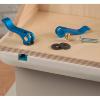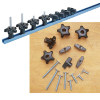You are using an out of date browser. It may not display this or other websites correctly.
You should upgrade or use an alternative browser.
You should upgrade or use an alternative browser.
Clever Idea for Mounting Reloading Tools
- Thread starter fmnnc
- Start date
- Status
-
Not open for further replies.
fmnnc
Member
scrat
Member
ok i guess now we are waiting to see the finished product.
AirplaneDoc
Member
Had not seen it, but I like it. Have you checked out the bench that Rembrandt has? I think it would be great in combination. For pics look at #190 in the "what have you invented thread". When I get moved, I am going to work on a newer better bench for myself and was thinking about doing something similar. Thank for the idea
FieroCDSP
Member
I've been looking for those things for a few weeks!!! I have a single stage mounted in a pre-existing spot too close to where I ended up mounting my Loadmaster. Every time I have to load rifle, I have to mount the single-stage, then pull it back off to use the LM again. I thought about those for a quick release, but couldn't find them. Thanks!!
fmnnc
Member
Unisaw
Member
I was at Rockler yesterday researching the same idea. I'm thinking that I will mount my presses to a plywood plate and then attach the plate to the t-track. I'm also thinking about having a shelf above the bench that has t-track so that I can adjust the position of powder measures.
ambidextrous1
Member
My Sears table saw has the same type locking clamps that are used when part of the table has to be extended. The cam levers are plastic instead of aluminum, and have worked well for four years. Aluminum cams are a plus, of course.
"I'm thinking that I will mount my presses to a plywood plate and then attach the plate to the t-track."
The plywood is liable to flex more than you want.
Even 2x lumber clamped down flexes unless you put the clamps on steel angle let into each end of the 2x.
I usually use a section of 2x6 or 2x8 (depending on press size).
Recess the nuts on the bottom, trim the ends to use 1 inch x 1 inch angle with a couple screws to hold it in places, the just plain old F-clamps to hold it to the bench.
The plywood is liable to flex more than you want.
Even 2x lumber clamped down flexes unless you put the clamps on steel angle let into each end of the 2x.
I usually use a section of 2x6 or 2x8 (depending on press size).
Recess the nuts on the bottom, trim the ends to use 1 inch x 1 inch angle with a couple screws to hold it in places, the just plain old F-clamps to hold it to the bench.
Unisaw
Member
My thought is that use of t-track would allow me to adjust the position of the press and to easily swap out one press for another when the need arises. YMMV.
Hoosier Reloader
Member
- Joined
- May 8, 2007
- Messages
- 68
I don't have any holes or slots in my benchtop (makes cleanup easier). My reloading tools are bolted to individual oak boards and the boards are C-clamped to the benchtop.
I started out this way because I didn't want to drill holes, ect until I was sure where I wanted to mount everything. I found that I like this set up because I can move things around or take them off in about 5 seconds. It has been working great for 3+ years.
I started out this way because I didn't want to drill holes, ect until I was sure where I wanted to mount everything. I found that I like this set up because I can move things around or take them off in about 5 seconds. It has been working great for 3+ years.
Snapping Twig
Member
- Joined
- Jul 7, 2007
- Messages
- 655
Nice! Bicycle quick releases for purposes other than bicycles!
Many years back I found a neat idea in the gun rags. Taking a 2 X 4 and cutting off a couple 4" segments, I glued and screwed them together so that looking at them from the end, they look like a "T".
I mounted my press permanently on the top of the "T" and when it's reloading time, I place the base of the "T" in my 5" vise and crank it down.
Same for my sizer/lubricator.
This way my workbench has only an innocuous vise mounted on it and friends/neighbors that aren't into the shooting sports don't have to know it's a reloading bench.
That and the fact that the wood, some screws and some glue were all on hand and I'm a cheap so and so.
Many years back I found a neat idea in the gun rags. Taking a 2 X 4 and cutting off a couple 4" segments, I glued and screwed them together so that looking at them from the end, they look like a "T".
I mounted my press permanently on the top of the "T" and when it's reloading time, I place the base of the "T" in my 5" vise and crank it down.
Same for my sizer/lubricator.
This way my workbench has only an innocuous vise mounted on it and friends/neighbors that aren't into the shooting sports don't have to know it's a reloading bench.
That and the fact that the wood, some screws and some glue were all on hand and I'm a cheap so and so.
creekwalker
Member
It does look nice and I'd like to see pictures of a press set up with it. I've used angle iron for bench or vise press mounting adaptations in the past. Gotta say though these set ups your discussing look a lot neater.
creekwalker
creekwalker
fmnnc
Member
Being a shop teacher I'm always running across various projects and plans. Here is one that I thought could easily be adapted from a lathe stand to a reloading bench. While at first glance I thought it would not be sturdy enough or even worse, likely to tip over, it was not until I read the fine print that I discovered their secret.

What we've done is to build two layers of 3/4" particleboard into the legs and top. Then, to add even more weight, a hollow beam runs between the legs. But how does a hollow beam add weight? The trick is to fill it with sand. This beam will hold almost 60 pounds of sand to further dampen vibration.
This website has some other great plans as well that are very suitable for reloading benches. http://www.plansnow.com/workbenchplans.html
Just thought I would share it with the group as I know someone is usually looking to build or upgrade their reloading bench.

What we've done is to build two layers of 3/4" particleboard into the legs and top. Then, to add even more weight, a hollow beam runs between the legs. But how does a hollow beam add weight? The trick is to fill it with sand. This beam will hold almost 60 pounds of sand to further dampen vibration.
This website has some other great plans as well that are very suitable for reloading benches. http://www.plansnow.com/workbenchplans.html
Just thought I would share it with the group as I know someone is usually looking to build or upgrade their reloading bench.
Clark
Member
The subject cam over locks are working against the compliance of the wood compression over the volume of the area of the washer times the thickness of the plywood. The stress strain curve of the wood is short. The wood will not spring back.
What does it all mean?
The tool can squish the wood.
It would be better to have a metal spring in the stack up.
What does it all mean?
The tool can squish the wood.
It would be better to have a metal spring in the stack up.
- Status
-
Not open for further replies.
Similar threads
- Replies
- 5
- Views
- 1K
- Replies
- 31
- Views
- 2K



